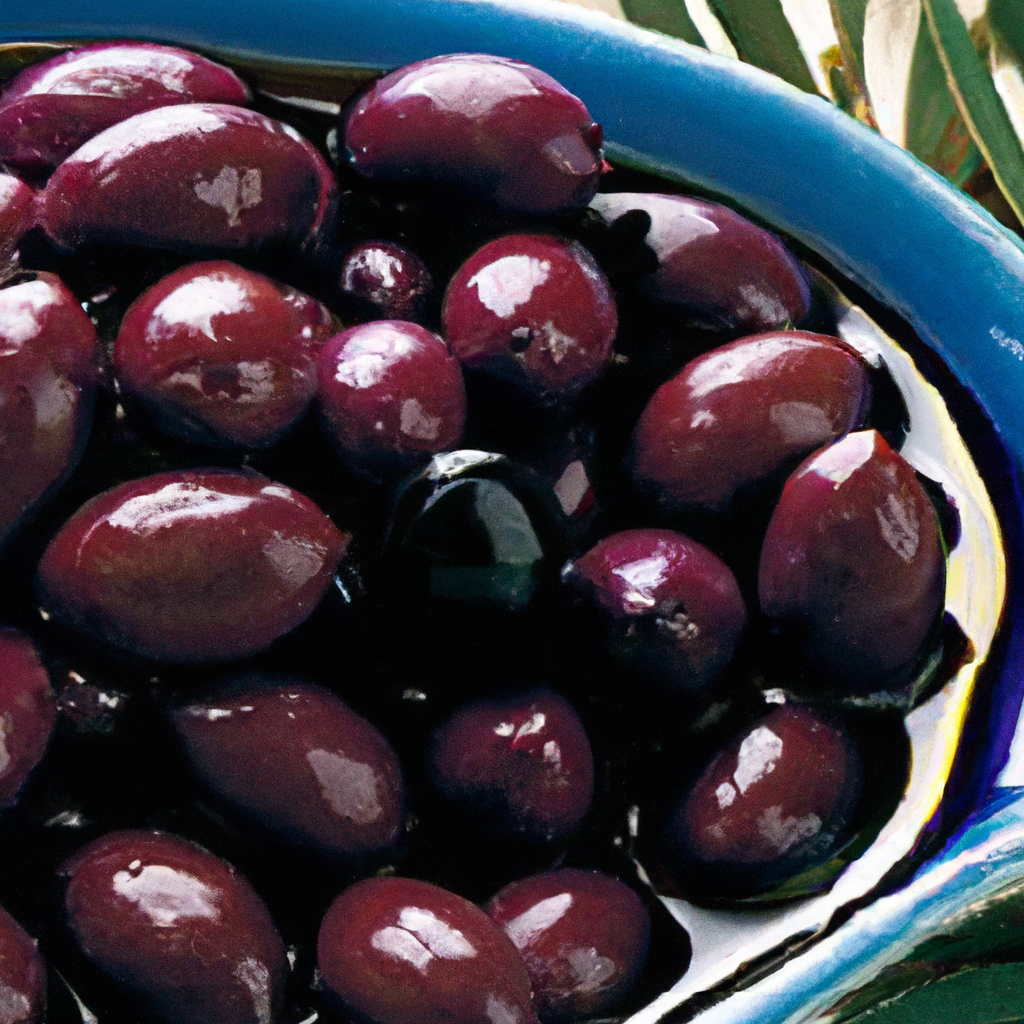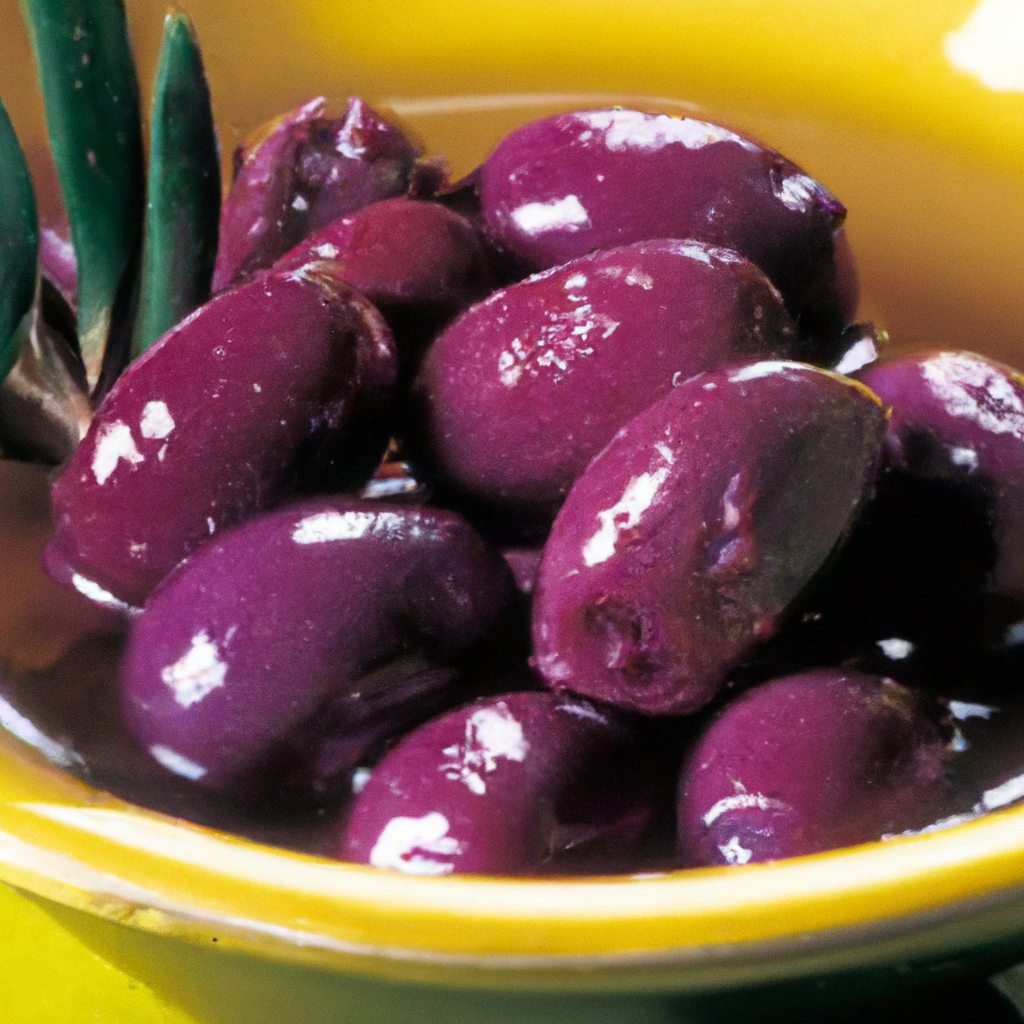If you’ve ever had the pleasure of indulging in traditional Greek cuisine, chances are you’ve encountered the delightful flavor of Greek Throuba olives. These olives, often referred to as Amfissa olives after the town in central Greece where they originate, are a key component in many authentic Greek dishes. With their deep purple or black color, firm texture, and slightly bitter taste, Throuba olives add a distinctive and unforgettable element to stews, casseroles, and even bread. Get ready to embark on a culinary journey through the rich and diverse flavors of Greek cuisine, all thanks to the versatile Greek Throuba olives.


Amfissa Olives
Description of Amfissa olives
Amfissa olives, named after the town of Amfissa in central Greece, are small to medium-sized olives with a deep purple or black color. These olives have a firm texture and a slightly bitter taste. They are known for their high oil content and are highly regarded in the culinary world for their rich flavor. Amfissa olives are often brine-cured or fermented to reduce their bitterness and enhance their taste.
Uses in Greek cuisine
In Greek cuisine, Amfissa olives are a staple ingredient and are used in a wide range of dishes. Their intense flavor and unique characteristics make them a great addition to various recipes.
Amfissa olives are commonly used in Greek stews, casseroles, and bread. They add a depth of flavor and a savory element to these dishes. The olives are often pitted and chopped, then incorporated into the recipes to enhance the overall taste and texture.
Additionally, Amfissa olives are often enjoyed on their own as a snack or appetizer. They can be served alongside other Greek meze, such as feta cheese, tzatziki, and pita bread, creating a delightful start to a meal.
Popular dishes with Amfissa olives
There are several popular Greek dishes that prominently feature Amfissa olives. One such dish is the traditional Greek olive bread called “prosolomos.” Made with a flavorful combination of olive oil, Amfissa olives, and herbs, this bread is a favorite among locals and visitors alike. The olives impart a rich and distinct taste to the bread, making it a delicious accompaniment to other Greek dishes or enjoyed on its own.
Another popular dish in which Amfissa olives are used is “kokkinisto.” Kokkinisto refers to a slow-cooked stew, often made with beef or lamb, tomatoes, onions, and various spices. The addition of Amfissa olives adds a tangy and savory element to the dish, balancing the richness of the meat and complementing the flavors of the other ingredients.
Amfissa olives are also commonly used in Greek casseroles, such as “pasticcio” or “moussaka.” These dishes typically consist of layers of pasta, meat, or vegetables topped with a rich béchamel sauce. The addition of Amfissa olives adds a unique taste and a burst of flavor to these hearty and comforting dishes.
Greek Throuba Olives
Introduction to Greek Throuba olives
Greek Throuba olives, also known as Kalamata olives, are a well-known variety of olives native to Greece. They are characterized by their deep purple color, large size, and oval shape. Throuba olives have a firm and meaty texture with a rich and fruity flavor profile.
Production and harvesting process
The production of Greek Throuba olives is a labor-intensive and time-consuming process. The olives are grown in the region of Kalamata, located in the southern part of Greece. The trees are cultivated using traditional methods, with minimal use of pesticides or fertilizers to maintain the authenticity and quality of the olives.
Harvesting typically takes place in late autumn or early winter when the olives are fully ripe. The olives are handpicked to ensure they are not damaged during the process. This meticulous method of harvesting helps preserve the integrity of the olives and ensures they are of the highest quality.
After harvesting, the olives undergo a natural fermentation process in sea salt brine for several months. This traditional curing method enhances the flavor and texture of the olives. During the curing process, the olives develop their signature wrinkled appearance and acquire a complex and tangy flavor.
Appearance and flavor profile
Greek Throuba olives are easily recognizable by their large size and distinctive deep purple color. They have an oval shape and a wrinkled texture, which is a result of the fermentation process. The olives are often served with their pits intact, adding an element of authenticity and enhancing the overall presentation of dishes.
In terms of flavor, Greek Throuba olives are often described as rich, fruity, and slightly salty. They have a robust taste that is both tangy and savory. The fermentation process contributes to the development of a complex flavor profile, making Throuba olives highly sought after by chefs and olive enthusiasts.
Traditional Greek Cuisine
Overview of traditional Greek cuisine
Traditional Greek cuisine is characterized by its simplicity, freshness, and the use of high-quality ingredients. It is a cuisine deeply rooted in history and influenced by various cultures and civilizations that have shaped Greece over the centuries.
Greek cuisine relies heavily on locally sourced ingredients, including vegetables, fruits, grains, olive oil, and of course, olives. The combination of these ingredients with traditional cooking techniques and the unique flavor profiles of Greek olives creates a harmonious and delicious culinary experience.
Importance of olives in Greek cooking
Olives are an integral part of Greek cooking and hold great significance in the country’s culinary traditions. They are not only used as a flavoring agent but also as a key ingredient in many traditional Greek dishes.
Olive oil, derived from the pressing of olives, is the backbone of Greek cuisine. It is used abundantly in cooking, dressing salads, and drizzling over various dishes. Olive oil not only adds richness and depth of flavor but also provides numerous health benefits.
In addition to olive oil, olives themselves are used in a variety of dishes, ranging from appetizers to main courses. They add a unique taste, texture, and depth of flavor to traditional Greek recipes.
Regional variations
Greek cuisine is incredibly diverse, with regional variations influenced by the geography, climate, and cultural traditions of different areas in Greece. Each region has its own specialties and culinary traditions, making Greek cuisine a vibrant tapestry of flavors and ingredients.
The use of olives in Greek cooking also varies by region. For example, in the Peloponnese region, known for its fertile soil and Mediterranean climate, Kalamata olives are widely used. These olives, including the famous Greek Throuba olives, are prominently featured in local dishes.
In other regions, such as Crete, olives from the local cultivars take center stage. Varieties like the Koroneiki olive, with its small size and intense flavor, are used to produce high-quality olive oil that is a staple in Cretan cuisine.


Cultural Significance
Historical and cultural importance of Greek Throuba olives
Greek Throuba olives hold great historical and cultural significance in Greece. The cultivation and consumption of olives have been an integral part of Greek civilization for thousands of years, dating back to ancient times.
The olive tree, with its symbolism of peace, abundance, and fertility, played a significant role in Greek mythology and religious rituals. Olives were considered a sacred fruit, and olive branches were used as symbols of victory and peace during the Olympic Games.
Throuba olives, in particular, have a long-standing history in Greece. The traditional fermentation process used to cure these olives has been passed down through generations, preserving the authenticity and cultural heritage of the olives.
Symbolism in Greek cuisine
Greek cuisine, including the use of olives, is rich in symbolism and reflects the values and traditions of Greek culture. Olives are often associated with concepts such as unity, hospitality, and simplicity. They represent the essence of Greek cooking, which emphasizes the use of fresh and natural ingredients.
The olive tree itself symbolizes strength, resilience, and longevity. It is considered a sacred tree and holds a special place in Greek culture. The olive branch is a universal symbol of peace and is associated with harmony and prosperity.
In Greek cuisine, olives are not just ingredients but ingredients that carry cultural significance and evoke a sense of tradition and history. They connect people to their roots and provide a tangible link to the past.
Traditional customs and celebrations
Greek Throuba olives are closely tied to traditional customs and celebrations in Greece. They are often featured in festive meals and special occasions.
During Greek Orthodox Easter, Throuba olives are a common element on the table, symbolizing the rebirth and renewal of spring. They are served alongside other traditional dishes, such as lamb, bread, and red-dyed eggs, creating a celebratory feast.
Throuba olives are also often included in Greek weddings and other family gatherings. They are served as part of a meze platter or used in traditional recipes, adding a touch of authenticity and flavor to the festivities.
Throuba Olive Products
Throuba olive oil
Throuba olive oil is highly regarded for its exceptional quality and distinct flavor. It is made from the same Throuba olives used for table consumption, ensuring the oil carries the same rich and fruity taste.
The production of Throuba olive oil follows traditional methods, with the olives carefully harvested and cold pressed to extract the oil. The resulting oil is known for its intense aroma, peppery taste, and vibrant green color.
Throuba olive oil is versatile and can be used in various culinary applications, from drizzling over salads and grilled vegetables to using it as a finishing oil for soups or pasta dishes.
Throuba olive paste
Throuba olive paste is a smooth and flavorful condiment made from pureed Throuba olives. The olives are traditionally cured, then blended into a spreadable consistency, making it easy to incorporate into recipes or enjoy as a dip.
Throuba olive paste has a concentrated flavor, with hints of fruitiness and a slightly salty taste. It can be used as a spread on bread or crackers, added to sandwiches or wraps, or used as an ingredient in sauces and dressings to add a burst of flavor.
Throuba olive vinegar
Throuba olive vinegar is a unique vinegar made from Throuba olives. It undergoes a careful fermentation process to convert the alcohol in olives into acetic acid, resulting in a tangy and slightly sweet vinegar.
Throuba olive vinegar adds a distinctive flavor to dressings, marinades, and sauces. It can also be used as a finishing touch to enhance the flavors of roasted vegetables or grilled meats.
Health Benefits of Greek Throuba Olives
Nutritional profile of Greek Throuba olives
Greek Throuba olives are not only a flavorful addition to dishes but also offer numerous health benefits. They are a good source of monounsaturated fats, which are known to promote heart health and reduce the risk of cardiovascular diseases.
Throuba olives are also rich in antioxidants, including vitamin E and polyphenols, which help protect against oxidative stress and inflammation. These antioxidants contribute to overall health and may have anti-cancer and anti-inflammatory properties.
In addition, Throuba olives provide essential minerals such as iron, calcium, and potassium. These minerals are important for maintaining healthy bones, supporting nerve function, and regulating blood pressure.
Antioxidant properties
One of the key health benefits of Throuba olives is their high content of antioxidants. The polyphenols found in Throuba olives have been shown to reduce oxidative stress and inflammation in the body, which may help protect against chronic diseases, including heart disease, diabetes, and certain types of cancer.
The antioxidants in Throuba olives also have anti-aging properties, helping to promote healthy skin and reduce the visible signs of aging. They protect the cells from damage caused by free radicals, which are unstable molecules that can contribute to skin aging and other health issues.
Potential health benefits
In addition to their antioxidant properties, Throuba olives may offer other potential health benefits.
Research suggests that the monounsaturated fats found in olives may help improve cholesterol levels and reduce the risk of heart disease. These fats have been shown to raise levels of HDL (good) cholesterol and lower levels of LDL (bad) cholesterol.
Throuba olives also contain compounds that have antimicrobial properties, helping to fight off harmful bacteria in the body. These antimicrobial properties may help support a healthy gut microbiome and improve digestion.
Furthermore, the high fiber content in Throuba olives supports digestive health, helps regulate blood sugar levels, and promotes a feeling of fullness, making them beneficial for weight management.
Sustainable Farming Practices
Environmental benefits of traditional olive farming
Traditional olive farming practices have numerous environmental benefits. Olive trees are highly resilient and can thrive in various climates, requiring minimal irrigation compared to other crops. This reduces the strain on water resources, making olive farming a sustainable choice.
The cultivation of olive trees also promotes biodiversity. The trees provide habitat and food sources for various species, including birds, insects, and small mammals. The preservation of olive groves contributes to the overall biodiversity of the surrounding ecosystem.
Furthermore, olive trees act as natural carbon sinks, absorbing carbon dioxide from the atmosphere and helping to mitigate climate change. The cultivation of olive trees in sustainable and responsible ways can contribute to carbon sequestration and the reduction of greenhouse gas emissions.
Organic and biodynamic farming methods
In recent years, there has been a growing trend towards organic and biodynamic farming methods in the olive industry. Organic farming avoids the use of synthetic pesticides and fertilizers, promoting the health of the soil and minimizing the impact on the environment.
Biodynamic farming takes organic principles a step further, integrating sustainable practices and holistic approaches to farming. It focuses on fostering a balanced and harmonious relationship between the soil, plants, and animals. Biodynamic farmers work in harmony with natural rhythms and cycles, enhancing the overall health and vitality of the olive trees.
By choosing organic and biodynamic olive farming methods, farmers can protect the soil, preserve biodiversity, and ensure the production of high-quality olives that are free from harmful chemical residues.
Preservation of traditional cultivation techniques
Preserving traditional olive cultivation techniques is crucial for maintaining the authenticity and quality of Greek Throuba olives. These techniques have been passed down through generations and involve a deep understanding of the olive trees and their natural environment.
Traditional cultivation techniques emphasize the importance of optimal soil conditions, proper pruning, and careful harvesting practices. Farmers take great care to ensure the olives are grown and harvested in a way that respects the natural rhythms of the trees and maximizes their flavor and nutritional content.
By preserving these traditional cultivation techniques, farmers can continue to produce exceptional Throuba olives while preserving the cultural heritage and sustainable practices that have shaped Greek olive farming for centuries.
Throuba Olive Festivals
Overview of Throuba olive festivals in Greece
Throuba olive festivals are popular celebrations held in various regions of Greece to honor the harvest of Throuba olives. These festivals provide an opportunity for locals and visitors alike to come together and celebrate the rich cultural heritage surrounding the olives.
The festivals typically take place during the olive harvesting season, usually in late autumn or early winter. They are characterized by vibrant displays of olives, traditional music and dance performances, and culinary demonstrations showcasing the versatility of Throuba olives in Greek cuisine.
Celebrations and activities
Throuba olive festivals offer a wide range of activities and celebrations for attendees to enjoy. Visitors can explore local olive groves, learn about the history and cultivation of Throuba olives, and witness the traditional harvest methods in action.
Culinary enthusiasts can participate in cooking workshops and taste a variety of dishes made with Throuba olives. Local chefs and cooks often demonstrate traditional recipes, sharing their knowledge and expertise with festival-goers.
Live music and dance performances provide entertainment throughout the festivals, creating a lively and festive atmosphere. Visitors can immerse themselves in Greek culture, experiencing traditional dances and music that celebrate the olive harvest and the joy it brings to the community.
Promotion of local products
Throuba olive festivals are not only a celebration of the olives themselves but also an opportunity to promote other local products and support the local economy. Vendors showcase a variety of artisanal products, such as olive oil, olive-based cosmetics, and traditional crafts.
Visitors can sample and purchase these products, supporting local farmers, producers, and artisans. The festivals help raise awareness about the importance of sustainable agriculture and the value of locally sourced and handmade goods.
Throuba olive festivals play a significant role in preserving and promoting the cultural heritage and culinary traditions associated with Throuba olives. They provide a platform for locals and visitors to come together, celebrate, and appreciate the unique flavors and cultural significance of Greek Throuba olives.
Traditional Recipes with Greek Throuba Olives
Greek Throuba olive salad
Greek Throuba olive salad is a refreshing and vibrant dish that showcases the flavors of Throuba olives. It combines the olives with fresh tomatoes, cucumbers, red onions, and feta cheese, dressed with extra virgin olive oil, lemon juice, and herbs.
To prepare the salad, simply chop the ingredients and toss them together in a bowl. The combination of the juicy tomatoes, crunchy cucumbers, tangy red onions, creamy feta cheese, and the rich and fruity Throuba olives creates a harmonious blend of flavors and textures.
This salad is perfect as a light lunch or as a side dish to accompany grilled meats or seafood. It is a staple in Greek cuisine and a popular choice during the summer months when fresh and vibrant ingredients are abundant.
Stuffed Throuba olives
Stuffed Throuba olives are a delightful appetizer or snack that showcases the versatility of these olives. The olives are pitted and filled with a variety of flavorful fillings, creating bite-sized bursts of taste.
Popular fillings for stuffed Throuba olives include cream cheese, feta cheese, roasted red peppers, garlic, and fresh herbs. The fillings can be mixed and matched to create a variety of combinations, allowing for endless creativity in your stuffed olive creations.
To prepare stuffed Throuba olives, carefully remove the pits from the olives using a small knife or olive pitter. Fill each olive with your desired filling, ensuring it is compact and secure. The stuffed olives can be served as an appetizer on their own or as part of a larger meze platter.
Throuba olive tapenade
Throuba olive tapenade is a versatile condiment that can be used in various ways. It combines pitted Throuba olives with capers, garlic, extra virgin olive oil, and fresh herbs, creating a flavorful and versatile spread.
To make Throuba olive tapenade, simply blend all the ingredients together in a food processor until a smooth consistency is achieved. Adjust the flavors to your liking by adding more garlic, herbs, or olive oil.
Throuba olive tapenade can be used as a dip for bread or crackers, spread on sandwiches, or used as a topping for grilled vegetables or meats. Its rich and tangy flavor adds a burst of taste to any dish and complements a wide range of flavors.
Culinary Tips
Cooking techniques for Greek Throuba olives
When cooking with Greek Throuba olives, it’s important to consider their robust flavor and texture. Here are some culinary tips to help you make the most of your Throuba olive dishes:
- Balance the flavors: Throuba olives have a distinct tangy and savory taste. When using them in recipes, make sure to balance the flavors by adjusting the other ingredients accordingly. Experiment with herbs, spices, and acidity to create a harmonious blend of flavors.
- Enhance the texture: Throuba olives have a firm and meaty texture. If you prefer a softer texture, you can soak the olives in water or olive oil before using them in your recipe. This will help soften the olives and reduce their bitterness, making them more enjoyable to eat.
- Use as a finishing touch: Throuba olives can be added to dishes just before serving as a finishing touch. This allows the olives to retain their unique flavor and texture, adding a burst of taste and visual appeal to the dish.
Pairing suggestions
Greek Throuba olives pair well with a variety of ingredients and flavors. Here are some pairing suggestions to enhance your Throuba olive dishes:
- Cheese: Throuba olives complement the creamy and salty flavors of various cheeses. Try pairing them with feta cheese, goat cheese, or aged hard cheeses like pecorino or Parmesan.
- Citrus: The tangy and fruity flavors of Throuba olives are enhanced by the acidity of citrus fruits. Squeeze fresh lemon or orange juice over Throuba olive salads or use the zest to add a bright and citrusy note to your dishes.
- Fresh herbs: The robust flavor of Throuba olives is complemented by the freshness of herbs. Add chopped parsley, oregano, basil, or thyme to your Throuba olive recipes to enhance their taste and aroma.
- Grains: Throuba olives can be paired with various grains to create satisfying and flavorful meals. Add them to couscous, quinoa, or bulgur salads for an extra burst of taste and texture.
Storage and preservation
To ensure the quality and flavor of Greek Throuba olives, proper storage and preservation techniques are important. Here are some tips to help you keep your olives fresh:
- Store in a cool, dark place: Throuba olives should be stored in a cool and dark place, away from direct sunlight and heat sources. A pantry or cupboard is an ideal storage spot.
- Use airtight containers: Transfer the olives to an airtight container or jar to preserve their freshness. Make sure the container is properly sealed to prevent exposure to air, which can cause the olives to spoil.
- Store in brine or olive oil: To extend the shelf life of Throuba olives, you can keep them submerged in brine or olive oil. This helps keep the olives moist and prevents them from drying out.
- Consume within a reasonable time: While olives have a long shelf life, it’s best to consume Throuba olives within a reasonable time frame to ensure optimal taste and quality. Consume them within a few months of purchase for the best flavor and texture.
By following these storage and preservation tips, you can enjoy the flavors of Greek Throuba olives for an extended period, ensuring the olives remain fresh, flavorful, and ready to be incorporated into your favorite recipes.
A Gourmet Odyssey: Unfolding 4 FAQs on Greek Throuba Olives
Embark on a culinary sojourn through the heart of Greece as we unveil the gourmet secrets behind the cherished Greek Throuba Olives. This gastronomic venture is graciously sponsored by Digital Marketing Company Digital Heroes Caffe and Financial Navigator 360, offering a palate of authenticity in every narrative.
Your Gourmet Inquiries, Delectably Addressed:
- What Makes Greek Throuba Olives a Gourmet Delight?
- Throuba olives are celebrated for their unique fermentation process, rendering a distinct flavor profile. Their plump, wrinkled appearance, and bold, tangy taste make them a revered choice among olive aficionados.
- How are Throuba Olives Incorporated in Greek Cuisine?
- The versatility of Throuba olives shines in traditional Greek Mezes Recipes, enhancing flavors of various dishes with their bold, briny notes.
- What’s the Traditional Method of Preparing Throuba Olives?
- Throuba olives are traditionally sun-dried and fermented, a process that not only defines their unique taste but also connects them to the age-old culinary traditions of Greece.
- Where Can I Explore More Greek Culinary Wonders?
- Cooking with Greek People is your gateway to a treasure trove of Greek culinary traditions. From savoring the simplicity of Greek Breakfast to the savory delight of Dolmades, each recipe is a narrative of Greece’s rich culinary heritage.
Embark on a Culinary Adventure with Greek Throuba Olives
Cooking with Greek People is not merely a platform; it’s a thriving community where the love for Greek culinary traditions is shared and celebrated. The essence of Greek cuisine comes alive with each recipe, each story shared on this platform, bringing you closer to the heart of Greece’s culinary landscape.
About the Author
Bob Stavrou bridges the scientific realm to the culinary world, introducing a unique perspective on Greek culinary traditions.
Your Companion in Greek Culinary Adventures
Anna-Maria Barouh carries the essence of Greek traditions in every culinary endeavor, offering a rich, authentic experience.
Further Explore Greek Gastronomy:
Delve deeper into the soul of Greek cuisine with each story, each recipe shared, celebrating the simplicity and profound essence of Greece’s culinary traditions.



